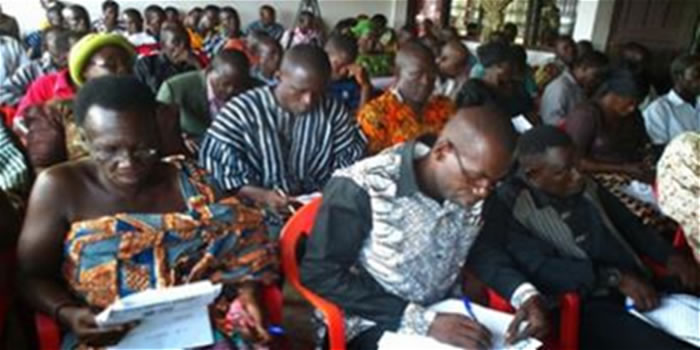

Introduction
A district’s population size and age-sex composition have broad ranging consequences for a number of socio-economic indicators such as the welfare of the people. An understanding of the age and sex structure of a population yields insights into changing population structure and highlights social and economic challenges. All levels of government need information on age and sex composition of the population in planning and development and in provision of services. This chapter therefore provides information on the age and sex of household members, the population size of the districts, the sex and dependency ratios as well as the migratory pattern within the districts. Population distribution by rural-urban residence is also discussed in addition to fertility and child survival.
Population Size, Age and Sex Distribution
Table 2.1 presents the population of the district by age, sex and sex structure. The district recorded a population of 112,706 made up of 54,293 males and 58,293 males. 5.1% share of the Regional Population and 0.46% of the National Population figure. This is also 23, 311 above the 2000 population and housing census of 89,395 representing 2.6% increment.
The sex ratio is the number of males per 100 females. Sex ratios that are higher than 100 indicate that there are more males than females but sex ratios under 100 indicate the reverse, i.e., more females than males. The sex ratio (92.9) presented in Table 2.1 shows that there are about 93 males to 100 females. This means that there are more females than males in the district. Among all the age groups, there are more females than males, except the age groups 0-19 which has a higher proportion of males than females.
Dependency ratio
The dependency ratio is the number of persons in the “dependent” ages (population under 15 years and 65 years and older) to those in the “economically productive” ages of 15–64 years. Three categories of dependency ratios are presented in Table 2.2, the child (0-14 years), the old age (65 year and older) and the combined (0-14 years and 65 years and older). For the district as whole, the dependency ratio is 95.4, made up of 10.6 for old dependency ratio and 84.8 child dependency ratio.
This dependency ratio implies that every 100 persons in the working ages support about 95 persons in the dependent ages. This ratio is higher in rural locality with 101 percent compared with 89.7 percent in the urban areas. This implies that in the predominantly rural communities in the districts, those in the working age support a higher dependent than their counterparts in the urban areas.
Population size by locality of residence
Table 2.3 shows the population by size and locality of residence in the district. The Table reveals that there were more residents in the rural (51.9%) than urban (48.1%) as of 2010. In addition, both sexes reside more in the rural (male-53.2% and female-50.7%) than urban (male-46.8% and female-49.3%). The district’s percentage of the regional population was 5.1 percent with 5.2 percent in urban and 5.0 percent in the rural areas.
Age and Sex Structure
The age–sex structure of the population of the district has a broad base, graphically represented by the population pyramid (Figure 2.1). Figure 2.1 shows that a large new cohort is born every year as displayed at the bottom of the pyramid (ages 0-4 years). As cohorts age, they inevitably lose members either through death or migration or both. This is shown by the narrowing of the population pyramid as it peaks. The peaking of the population accelerates after age 45 years. Another feature of the district population pyramid is that females in the oldest age groups form the substantial majority.
Fertility, Migration and Mortality
Fertility
Fertility refers to the actual birth performance i.e. frequency or childbearing among a population. The total fertility rate (TFR) which is widely used in the analysis of fertility is the average number of live births among 1,000 women exposed throughout their childbearing years (15-49 years) to the schedule of a given set of age specific fertility rates, assuming no women died during the childbearing years. There are other fertility measures such as the General Fertility Rate (GFR), the Crude Birth Rate (CBR), among others used in the 2010 census.
The general fertility rate is the number of births in a given year divided by the mid-year population of women in the age groups 15-44 and 15-49. This analysis used women between 15 and 49 years because women in the district still have births after age 45. The crude birth rate (CBR) is the simplest and most frequently used measure of fertility. It is easy to calculate because it requires only the total number of births and the total population. It is crude and always expressed per 1000 population. It is crude because it includes all ages and both sexes in the denominator.
Table 2.4 presents information on the Total Fertility Rate for women aged 15-49 years. The TFR in the district is 4.68 births per woman. This means that a woman in the district would have, on the average, between 4 and 5 children in her lifetime. This however appears to be higher than the regional average of 3 or4 births per woman. The district also recorded a GFR of 136.7which is the number of births per 1000 women aged 15- 49 years. This is also higher than the regional average of 106.6. CBR as presented in the table is31.2. This average means that there are 31 live births per 1000 population in the district.
Children ever born and surviving
The number of children ever born per woman measures the lifetime or cumulative fertility performance of female respondents in the reproductive age group 15-49 years. About 126,154 children have ever been born and 105,421 are surviving by 38,988 women aged 12- 60 years and above in the district (Table 2.5). The data also show that the number of children ever born increases with age but reaches its peak at 44 years for female population aged 12 years and older.
The same trend is observed for children surviving who also increased with age and reaches its peak at 44 years for the same female population aged 12 years and older. Children surviving include all children (male and female) born alive by the female concerned who are still living. The data shows that about 84 percent representing 105,421 of children born to women of childbearing ages (12- 49 years) in the district survive. This means that more than four in every five children (84%) survive in the district. However, the data show variations among the age groups in the district.
Migration
Table 2.6 shows the percentage distribution of the people of the districts by place of birth. The data include those who were enumerated in the district during the census period but were born outside the region. Of those enumerated in the district, 22,931 representing 70.8 percent were born within the central region, while 27.5 percent were born in another locality in another region and the rest (1.9%) were born outside the country. It is observed that about 60.7 percent of the migrants in the district have been staying in the district for the past five year to over twenty years compared with the 39.3 percent in the past four years.
Mortality
Mortality, as one of the three components of population growth, plays an important role in determining the growth of a population. The level and pattern of mortality is a reflection of the health status of a population. Table 2.7 presents the total number of deaths and crude death rate in the district. Out of the total population of 112,706, 1,114 deaths were recorded at the household level. The crude death rate which measures the number of deaths per 1,000 populations is 9.88. This means that on the average, there is 9 to 10 death per 1000 population in the district. This however appears to be higher than the regional average of 7 or 8 death per 1000 population.
Causes of death
Table 2.8 provides information on deaths which occurred in the household during the last 12 months due to accidents, violence, homicide or suicide. The data show that eleven percent of the total death recorded in the district is due to accidents, violence, homicide and suicide while eighty-nine percent are due to other causes. The percentage of death caused by accident, violence, homicide or suicide is just below the regional figure of 14.1 percent.
Reported age specific death rate
Death rates are calculated for specific age groups in order to compare mortality at different ages or at the same age over time. The reported age specific death rate (ASDRs)is computed as the number of deaths of people in a specified age group, for example deaths among the 20-24 year-age group to the population in that age group (20-24 years) multiplied by 1,000.Figure 8.3 provide information on age specific death rates. The data show that death rates for males and females are higher in ages 0-4 but lowest at ages 5-14.
The death rates start rising at ages 15-19 and intensifies with increase in age. Between ages 15-54 (the reproductive period), ASDRs for females and males are alternating with males been higher than females at ages 20-34 and females been higher than males at 35-54. ASDRs for males are higher at ages 55 years and older than females and this is an indication of a lower life expectancy for males compared to females. Additionally, at ages 50 years and older, differences between male and female ASDRs are very high compared with the lower age groups.
Date Created : 11/14/2017 3:31:16 AM










 facebook
facebook
 twitter
twitter
 Youtube
Youtube
 +233 593 831 280
+233 593 831 280 0800 430 430
0800 430 430 GPS: GE-231-4383
GPS: GE-231-4383 info@ghanadistricts.com
info@ghanadistricts.com Box GP1044, Accra, Ghana
Box GP1044, Accra, Ghana